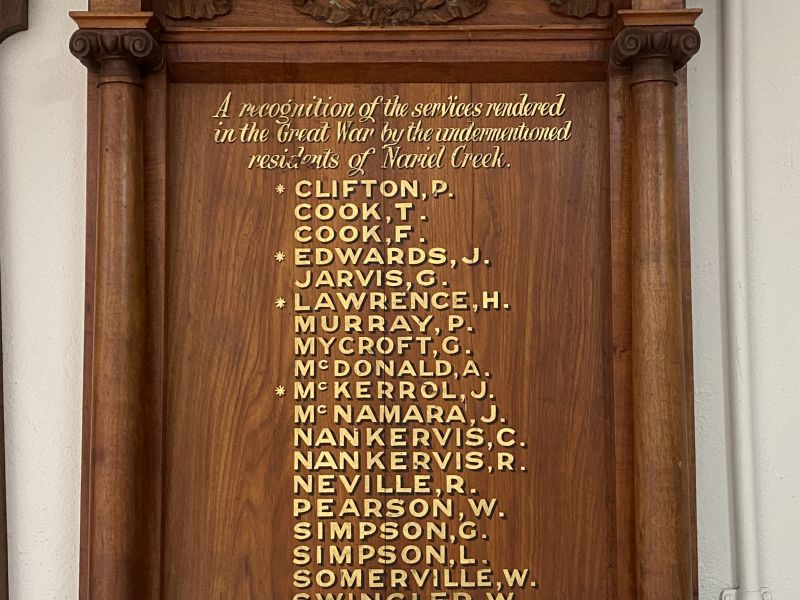Frederick Charles Cook
Born on the 24th of July, 1894, at Aston, Warwickshire, England, Fred was the second youngest of eight children of Richard and Susan (née Bradford) Cook. At the time of his birth his family was living at 18 Sydney Road Aston, in the West Midlands of England. Fred’s father, Richard, had previously been a private in the 17th Leicestershire Regiment, having fought in the Afghan war between 1878 and 1880.
At the age of 16, Fred was still living in his family’s home, at 18 Sydney Road, and working as a factory hand at B Masons & Sons, a factory in Wharf Street, Aston, producing copper alloy strips. It is not exactly known when Fred immigrated to Australia. The only passenger record showing a Frederick Cook is one from the SS Cassel, which berthed in Melbourne in October of 1912. Fred’s mother passed away on the 14th of April, 1915, although it would have been some time until he heard this news, as he would have been in Australia by this time.
On the 7th of January, 1916, Fred wrote a letter to his eldest sister, Elizabeth, whom he affectionately called ‘Tot’. In it he mentions to her how is about to enlist and that he was sorry to hear about his brother, Ernest. (Ernest Stanley was a lance-corporal in the 8th Battalion of the King's Royal Rifle Corps and was killed in action on the 30th July, 1915, at Hooge Chateau, north-east of Ypres, in a battle that, for the first time, saw the German army use flamethrowers against the English forces.) He also explains that he intends to make out his will to her, just in case something happens. Lastly, he tells Tot that he has been lucky so far in that for the past three weeks he had been earning 10 shillings a day harvesting around Corryong.
Fred enlisted at Seymour, Victoria on the 11th of March, 1916. He was allocated to the 17th Reinforcements to the 8th Battalion, and given the Regimental Number 5361.
Fred’s second letter to Tot was written on the 12th of March, 1916, from the Methodist Soldiers Tent at the Broadmeadows training camp just outside of Melbourne. While the letter is short, he explains how someone named Mack has joined the Red Cross instead of the Infantry, as he “got cold feet”. He indicates that although not much of interest is happening at the moment, he suspects that they will be embarking to go overseas in about six weeks. He also asks what she thought of the photograph that he had sent her in a previous letter.
While at sea, aboard HMAT A14 Euripides, Fred again wrote to Tot. He explains that the officers won’t allow them to write anything about the ship or where they are going. However, he does mention that the trip has been rough and that while many men have been seasick, he has been fine. He warns Tot not to mention how he has left everything in his will to her as his Aunt Lizzy would ‘cry out’ about him not leaving anything to his father. A cryptic comment of “I please myself and understand things better now, you know what I mean” indicates a possible rift in family relationships.
On the 14th of May, 1916, the 17th Reinforcements disembarked at Suez in Egypt. The next few months were spent training before they embarked once again, arriving in England on the 21st of August and being stationed at Perham Downs Training camp. He wrote another letter to Tot to let her know that he had arrived in England safely and how pleased he was to have been met by Lucy (another sister) and Teddy (Elizabeth’s husband). He explained that he had fixed all of his banking and will details. He mentioned that he thought his battalion wouldn’t be heading overseas to France for a while and that they were to be stationed at Epsom, near London. Finally, he told her that the fat bacon she had sent him had gone down well but that he would “wait until we get a poor meal before I eat the fish then I shall enjoy it.”
Fred and his mates were only in England a few days before they were sent overseas to France. Perhaps his comment about remaining in England for a longer stretch of time was written to comfort his sister, who had already lost a brother in the war. He arrived at Etaples in northern France on the 23rd of August, then spent the next two weeks in training at the 1st Australian Division Base Depot before finally joining the 8th Battalion, 2nd Brigade, 1st ANZAC Corp, on the 10th of September, 1916.
At the beginning of November, 1916, the 8th Battalion was in the Pommiers Camp, which was located about 10 kilometres from the front line at Gueudecourt. The cold, wet winter had set in by now and as the battalion moved up to the front they walked in mud up to their knees, and in some spots their waists. The combination of cold, constant rain, mud and heavy shelling every half an hour made life extremely difficult in the trenches, with many suffering from exposure. On the 6th of November a particularly heavy bombardment rocked the trenches resulting in Fred’s death, along with Privates Hanlon, Moore and White. A further 14 were wounded.
Fred has no known grave. He is remembered at the Villers-Bretonneux Memorial, Villers-Bretonneux, Picardie, France, the Australian War Memorial Roll of Honour, the Aston Parish Church WW1 Memorial in Warwickshire, England, and the Nariel Creek Roll of Honour. He was also one of the original soldiers remembered in the pine tree Avenue of Honour, in Corryong, Victoria. For his service during the First World War, he was awarded the British War Medal and the Victory Medal.
 Stephen Learmonth
Stephen Learmonth